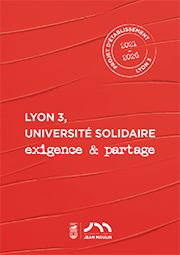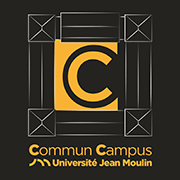AccueilRechercheLes productions scientifiquesThèsesThèses soutenuesThèses soutenues - 2006-2020Thèses soutenues - 2011
-
Partager cette page
- Recherche,
- Philosophie,
LECLERC Christian
Des dispositifs géosensibles
Publié le 20 octobre 2011 – Mis à jour le 29 novembre 2011
Thèse en Philosophie - Etude des systèmes soutenue le 24 septembre 2011
Face à l'uniformisation marchande du monde, aux épreuves de synthèses technologiques et industrielles, aux discrédits de la nature méthodiquement consentis, à l'asservissement machinique de notre sensibilité, l'homme apparaît, comme les artefacts qu'il a créés, semblable à une entité idéalisée et artificielle, inadaptée à son milieu. Comment ré-envisager alors nos modalités de créativité et de générativité au-delà du paradigme humaniste finissant, par-delà cette crise multiple de la pensée et de l'identité, de l'espace et de la représentation ?
La conversion des principes métaphysiques et substantialistes nous oriente auprès de sentirs transindividuels, vers un devenir non humain de l'être-par-delà-le-sujet. Penser les valences entre intelligibilité et sensibilité, les médiances entre être technique et naturel, les transjections entre entendement et imagination suppose de reconsidérer la nature de l'être au-delà de ses forces de détermination, dans la puissance de sa vulnérabilité.
Cet essai d'esthétique sur la créativité spatiale contemporaine s'attache à établir à l'aune de la révolution numérique une poïétique géosensible, transverse et trilogique, qui questionne conjointement les processus actuels de création artistique, de conception architecturale et de conceptualisation philosophique. Il s'accorde à penser l'acte créatif à partir du concept de dispositif géosensible, application spatiale du devenir-frémissant et de ses modalités que sont les fragmentations, les micro-hétérogénéisations et les fluences.
La conversion des principes métaphysiques et substantialistes nous oriente auprès de sentirs transindividuels, vers un devenir non humain de l'être-par-delà-le-sujet. Penser les valences entre intelligibilité et sensibilité, les médiances entre être technique et naturel, les transjections entre entendement et imagination suppose de reconsidérer la nature de l'être au-delà de ses forces de détermination, dans la puissance de sa vulnérabilité.
Cet essai d'esthétique sur la créativité spatiale contemporaine s'attache à établir à l'aune de la révolution numérique une poïétique géosensible, transverse et trilogique, qui questionne conjointement les processus actuels de création artistique, de conception architecturale et de conceptualisation philosophique. Il s'accorde à penser l'acte créatif à partir du concept de dispositif géosensible, application spatiale du devenir-frémissant et de ses modalités que sont les fragmentations, les micro-hétérogénéisations et les fluences.
Faced with the mercantile globalisation of the world, the processes of technological and industrial syntheses, the discreditation of nature which has been methodologically consented to, and the mechanical subservience of our sensibilities, human beings appear, like the artefacts they have created, like idealised and artificial entities, ill-adapted to their surrounding world.
How can we then re-envisage our creative and generative modalities beyond the humanist paradigm which is drawing to an end, outside this multiple crisis of identity and thought, and of space and representation. The conversion of metaphysical and substantialist principles orients us towards transindividual feelings for a post-human becoming of the being-outside-the-subject. Thinking the valencies between intelligibility and sensibility, the mediancies between technical and natural being, the transjections between comprehension and imagination, postulates reconsidering the nature of the being beyond its powers of determination, in the strength of its vulnerability.
This essay on the aesthetics of contemporary spatial creativity seeks to establish, in light of the digital revolution, a geosensible poïetics, transversal and trilogical, which conjointly questions the current processes of artistic creation, architectural conception, and philosophical conceptualisation. It seeks to think the creative act from the point of view of the concept of the geosensible device, a spatial application of a becoming-trembling, and of its modalities which are fragmentations, micro-heterogenisations, and fluences.
Mots clés : Dispositif, création, conception, conceptualisation, process, trans-sensorialité, vulnérabilité, force-fragile, Champ, milieu, devenir spatial, perception scopique, transjection, fragmentations, micro-hétérogénéisations, fluences
G. Deleuze, F. Guattari, J. Derrida, M. Heidegger, M. Duchamp, J. Wall, D. Gonzalez-Foerster, P. Eisenman, R. Koolhaas, Herzog & de Meuron
Key words : Dispositif, création, conception, conceptualisation, process, trans-sensorialité, vulnérabilité, force-fragile, Champ, milieu, devenir spatial, perception scopique, transjection, fragmentations, micro-hétérogénéisations, fluences
G. Deleuze, F. Guattari, J. Derrida, M. Heidegger, M. Duchamp, J. Wall, D. Gonzalez-Foerster, P. Eisenman, R. Koolhaas, Herzog & de Meuron
Directeur de thèse : Chris YOUNES
Membres du jury :
Daniel PAYOT, Professeur, Université de Strasbourg
Anne SAUVAGNARGUES, Professeur, Université de Paris Ouest Nanterre
Véronique FABBRI, Maître de conférences, HDR, Ecole Nationale Supérieure d'Architecture de Paris la Vilette
François GUERY, Professeur, Université Jean Moulin Lyon 3
Chris YOUNES, Professeur, Ecole Nationale Supérieure d'Architecture de Paris la Vilette
Président du jury : François GUERY
Mention : Très Honorable
Equipe d'accueil : IRPHIL
How can we then re-envisage our creative and generative modalities beyond the humanist paradigm which is drawing to an end, outside this multiple crisis of identity and thought, and of space and representation. The conversion of metaphysical and substantialist principles orients us towards transindividual feelings for a post-human becoming of the being-outside-the-subject. Thinking the valencies between intelligibility and sensibility, the mediancies between technical and natural being, the transjections between comprehension and imagination, postulates reconsidering the nature of the being beyond its powers of determination, in the strength of its vulnerability.
This essay on the aesthetics of contemporary spatial creativity seeks to establish, in light of the digital revolution, a geosensible poïetics, transversal and trilogical, which conjointly questions the current processes of artistic creation, architectural conception, and philosophical conceptualisation. It seeks to think the creative act from the point of view of the concept of the geosensible device, a spatial application of a becoming-trembling, and of its modalities which are fragmentations, micro-heterogenisations, and fluences.
Mots clés : Dispositif, création, conception, conceptualisation, process, trans-sensorialité, vulnérabilité, force-fragile, Champ, milieu, devenir spatial, perception scopique, transjection, fragmentations, micro-hétérogénéisations, fluences
G. Deleuze, F. Guattari, J. Derrida, M. Heidegger, M. Duchamp, J. Wall, D. Gonzalez-Foerster, P. Eisenman, R. Koolhaas, Herzog & de Meuron
Key words : Dispositif, création, conception, conceptualisation, process, trans-sensorialité, vulnérabilité, force-fragile, Champ, milieu, devenir spatial, perception scopique, transjection, fragmentations, micro-hétérogénéisations, fluences
G. Deleuze, F. Guattari, J. Derrida, M. Heidegger, M. Duchamp, J. Wall, D. Gonzalez-Foerster, P. Eisenman, R. Koolhaas, Herzog & de Meuron
Directeur de thèse : Chris YOUNES
Membres du jury :
Daniel PAYOT, Professeur, Université de Strasbourg
Anne SAUVAGNARGUES, Professeur, Université de Paris Ouest Nanterre
Véronique FABBRI, Maître de conférences, HDR, Ecole Nationale Supérieure d'Architecture de Paris la Vilette
François GUERY, Professeur, Université Jean Moulin Lyon 3
Chris YOUNES, Professeur, Ecole Nationale Supérieure d'Architecture de Paris la Vilette
Président du jury : François GUERY
Mention : Très Honorable
Equipe d'accueil : IRPHIL
Documentation
Mise à jour : 29 novembre 2011



